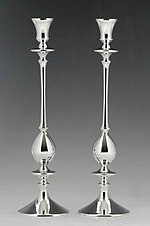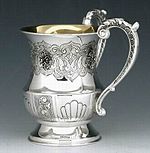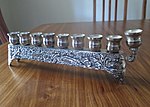Jewish ceremonial art



Jewish ceremonial art is objects used by Jews for ritual purposes. Because enhancing a mitzvah by performing it with an especially beautiful object is considered a praiseworthy way of honoring God's commandments, Judaism has a long tradition of commissioning ritual objects from craftsmen and artists.[1]
Jewish ceremonial art forms a large part of Judaica (/dʒuːˈdeɪ.ɪkə/), a general academic and art trade term for Jewish-related objects, of which other types are manuscripts, books and other printed materials, artworks in various media, and clothing.
Textual origin[edit]
Multiple early rabbinic commentaries on the Hebrew Bible refer to sanctifying rituals with visually pleasing objects in the Midrash. Midrash Mekhilta of Rabbi Ishmael has this teaching on a biblical verse:
"This is my God and I will glorify Him" (Exodus 15:2)
Is it possible for a human being to add glory to his Creator? What this really means is: I shall glorify God in the way that I perform commandments. I shall prepare a beautiful lulav, beautiful sukkah, beautiful fringes (tzitzit), and beautiful tefillin.[citation needed]
Other Midrash teachings (e.g. Shir HaShirim Rabbah 1.15) offer the same idea. This idea is expanded upon in the Babylonian Talmud (e.g. Bāḇā Qammā 9b). This teaching was understood by succeeding generations as a duty, when possible, to make beautiful items used in Jewish life and worship, both physical and textual.
Items used on Shabbat[edit]

The following items are used during Shabbat:
- Kiddush cup: Kiddush, literally, "sanctification", is a blessing recited over wine or grape juice to sanctify the Shabbat and Jewish holidays. Kiddush cups are highly decorated, and are generally made of china, porcelain, silver, pewter and nickel.
- Shabbat candlestick holders
- Hand washing cup ("netilat yediam")
- Challah cutting board and cover
- Havdalah candle and candle holder
- Havdalah spice box
The end of the Jewish Shabbat is marked by the brief prayer ceremony of Havdalah, which usually takes place in the home. Part of the ceremony requires sniffing a sweet-smelling spice or plant. In Jewish communities around the Mediterranean, a sprig of a sweet-smelling shrub was customarily used, in Northern Europe by the twelfth century there are literary references of the use of a specially designed spice box or container. The oldest surviving spice boxes for Havdalah date to the mid-sixteenth century. The Jewish Museum (New York) has a German example c. 1550 thought to originate in Frankfurt am Main.[2]
Hanukkah items[edit]

The menorah (or hanukkiah) used on the Jewish holiday of Hanukkah is perhaps the most widely produced article of Jewish ceremonial art.[3][4][5] The Lindo lamp is a particularly fine example by an 18th-century silversmith. Contemporary artists often design menorahs, such as the gold-plated brass menorah with 35 moveable branches designed by Yaacov Agam.[6] A silver menorah by Ze'ev Raban from the 1930s is in the Judaica Collection of the North Carolina Museum of Art.[7]
- Chanukah menorah
- Dreidels
- Gelt holder
- Chanukah candles or Oil
Sukkot items[edit]

- Esrog Box
To protect the esrog during the Sukkot holiday, it is traditionally wrapped in silky flax fibers and stored in a special box, often made from silver.[8]
In modern times, the esrog is also commonly wrapped in synthetic netting, and placed in cardboard boxes. Wooden boxes are increasingly popular as well.
Books[edit]
Passover haggadah[edit]
The tradition of artistically embellished haggadahs, the Jewish text that sets forth the order of the Passover Seder, dates back to the Middle Ages. The Sarajevo Haggadah of 1350 is a celebrated example. Major contemporary artists have produced notable haggadahs, such as the Szyk Hagaddah. See also the facsimile edition of the even earlier Barcelona Haggadah[9] of 1340.
Notable Judaica collections[edit]
Museums with notable collections of Jewish ceremonial art include the British Library,[10] the Israel Museum, the Jewish Museum (London), the Musée d'Art et d'Histoire du Judaïsme in Paris, the Jewish Museum in Prague, the North Carolina Museum of Art,[7] the Jewish Museum (New York), the Musée Lorrain in Nancy,[11] the Musée alsacien in Strasbourg and the Contemporary Jewish Museum of San Francisco.[12] The Museum of Jewish Heritage in Battery City Park, New York City also holds a sizable collection. Another way to see Judaica is through the art marketplace, including auction houses. Sotheby's, Bonhams-New York, Skinner's and Kestenbaums routinely hold regular auctions each year.
See also[edit]
Other items[edit]
- Mizrach, object indicating the direction of prayer
- Parochet, curtain of the Torah Ark
- Shiviti, meditative text
References[edit]
- ^ Kanof, Abram (1982). Jewish Ceremonial Art and Religious Observance. New York: Abrams. ISBN 9780810921993.
- ^ "Spice Container". The Jewish Museum. thejewishmuseum.org. Retrieved 2016-12-23.
- ^ Luminous Art: Hanukkah Menorahs of The Jewish Museum, Susan L. Braunstein, Jewish Museum, New York, 2004
- ^ Lighting the Way to Freedom: Treasured Hanukkah Menorahs of Early Israel, Aaron Ha'tell, Yaniv Ben Or, Devora Publishing (November 29, 2006)
- ^ Berman, Nancy M. (2016). The Art of Hanukkah. Universe Publishing. ISBN 9780789332516.
- ^ "Agam Brass Menorah". www.herndonfineart.com. Archived from the original on 2016-12-23. Retrieved 2009-07-30.
- ^ a b "Mending Wounds in the Judaic Collection – North Carolina Museum of Art | Untitled". Archived from the original on May 15, 2009.
- ^ "Redirecting..." www.aish.com. 26 January 2003. Archived from the original on 1 March 2020. Retrieved 4 October 2011.
{{cite web}}: Cite uses generic title (help) - ^ "Facsimile Editions - Barcelona Haggadah". www.facsimile-editions.com.
- ^ "The Barcelona Haggadah: Haggadah, liturgical poems and biblical readings for Passover, Sephardic rite". British Library.
- ^ Les Juifs et la Lorraine, un millénaire d'histoire partagée, Musée Lorrain, Nancy ; Somogy – Éditions d'Art, 2009, p. 164 ; this collection is temporarily not on public display in 2017.
- ^ "The CJM - The Contemporary Jewish Museum". www.thecjm.org.
